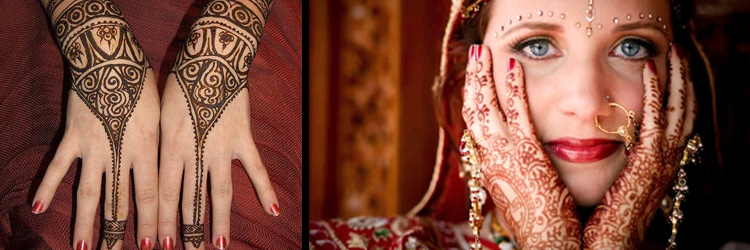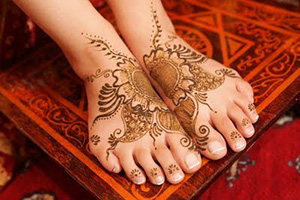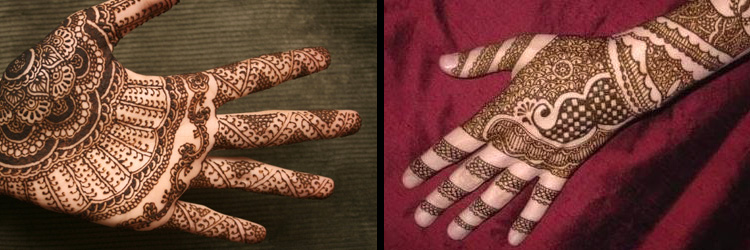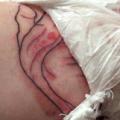


Henna tattoos are temporary tattoos made from a dye that is extracted from the Henna plant. Henna has been used to dye skin, hair and fingernails as well as fabrics across the ages along with black henna and neutral henna that are not derived from the henna plant as their name implies.
The Henna plant is native to North Africa, south and west Asia and Australasia. It produces the most amount of dye when it is grown in temperatures between 35 and 45 degrees.
Unless they are broken Henna leaves will leave no stain on the skin, they will only stain the skin if they are smashed with a mildly acidic liquid, a process that releases the lawsone molecules from the leaf. Henna is often traded as a powder that is mixed with lemon juice or strong tea to make the toothpaste type consistency needed for body art. The mixture must be left for between six and twenty four hours before use. The quality of the stain can be improved by adding oils with high levels of monoterpene alcohols like lavender, eucalyptus or tea tree.
 Once the paste is ready it can be applied with the fingers or tools. The longer the paste is left on the skin the darker the stain will be. The paste needs to be left on for several hours if a dark tattoo is required. The paste can be sealed by dabbing a sugar and lemon mix over it to prevent it from drying out and flaking off. Sugar can also be added to the paste to prevent it drying out. The paste is simply brushed or scraped away at the end of the allotted time.
Once the paste is ready it can be applied with the fingers or tools. The longer the paste is left on the skin the darker the stain will be. The paste needs to be left on for several hours if a dark tattoo is required. The paste can be sealed by dabbing a sugar and lemon mix over it to prevent it from drying out and flaking off. Sugar can also be added to the paste to prevent it drying out. The paste is simply brushed or scraped away at the end of the allotted time.
To start off with a henna stain will be orange in appearance. Over the course of a few days it will darken and become a reddish brown color. The darkest and most long lasting stains will appear on the palms of the hands and the feet as they have the thickest layers of skin that can take in the most Lawsone. The stain can be made darker by steaming the skin, either white the past is still in contact with the skin or after it has been removed.
Henna has been used as body art as part of social celebrations in the Mediterranean since the late Bronze Age. Statuettes have been found from 1500 and 500 BCE of young woman with what appears to be henna markings on their hands. The worldwide celebration of the Night of Henna has its origins in the early connection made between young, fertile women and henna.
The Night of Henna is celebrated by Muslims, Hindus, Jews and Christians in areas where the plant grows naturally. Henna has traditionally been applied for luck as well as joy and beauty. Brides typically used the most henna and in some traditions the designs are so complex it can take up to five days for the to be applied.
Henna is generally a very safe dye, however it is known to be dangerous to people with glucose-6-phospate dehydrogenase deficiency, more commonly found in males than females. Henna can cause allergic reactions and in the USA it is thought that the health risks in pre-mixed pastes pose a considerable health risk, the Food and Drug Administration (FDA) considers these risks to be adulterants and therefore illegal for use on the skin.

This will depend upon the size and design of the tattoo, small henna tattoo on the palms of the hands can take as little as five minutes.
Once the paste has been applied you need to ensure that you do not smear it. Once the paste is off no real aftercare is required.
The paste will be dry anywhere between five and ten minutes, if sugar and lemon juice are put on once it is dried then it will take a further five minutes to dry out again. Many henna tattoo artists recommend that you have a henna tattoo last thing at night so you can go to bed with the paste on and have the best color possible when you wake up in the morning. The dry paste that will flake off during the night will not stain the bed sheets and any remaining paste on the body in the morning can be taken off in the shower.
A henna tattoo typically lasts for around three weeks, but factors such as how often you wash the area and which part of the body the henna tattoo was a applied to will affect its longevity. Using less soap and avoiding washing the area will extend the life of the tattoo.
Henna is not black, so anybody who offers you a black henna tattoo is not using henna, or they are using henna with an additive that can potentially harm your skin.
Traditionally henna tattoos were only applied to the hands and feet on women for a special occasions such as weddings. Today they are applied to any part of the body you wish. Some people who are considering a permanent tattoo will have a temporary henna one in its place first to see how they feel about the size and design before they commit to a permanent piece of body art.








